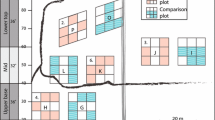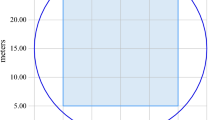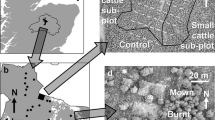Abstract
Open range grazing by cattle is common on heterogeneous montane landscapes in western Canada. These areas are often jointly managed for forestry, leading to concerns over forest re-establishment following clear cut harvest and cattle impacts on tree regeneration. A network of 154 field plots were used to examine cattle utilization across five coniferous cut blocks within three large pastures of SW Alberta over a 2 year period. Specific objectives were to: (1) quantify cattle presence across cut blocks under free-choice conditions; (2) identify the environmental factors responsible for observed patterns of cattle presence, including topography, distance to water, forage characteristics and slash properties; and (3) document cattle impact on conifer seedlings. Averaged over 2 years, evidence of cattle was found in 46 % of plots, primarily as herbage removal. Cattle presence across logged areas was associated with plots at lower elevations and closer to water, and to a lesser extent, those areas with greater forage biomass but lower quality. Forest surveys done 3 years after harvest indicated most tree regeneration consisted of planted lodgepole pine (Pinus contorta Loudon) and naturally regenerating Douglas-fir (Pseudotsuga menziesii (Mirb.) Franco). While regeneration among plots remained below the provincial requirement of 80 % stocking, ranging from 68 to 77 % among cut blocks, this deficit was not attributed to cattle impact, as only two tree seedlings surveyed had evidence of livestock-induced damage. Finally, cattle visitation to plots was lower with taller slash in select pastures, suggesting slash may deter cattle use of some cut blocks. Overall, the results of this study support the notion that forest management and cattle grazing are compatible uses on Montane landscapes managed for multiple purposes.



Similar content being viewed by others
References
Alberta Environment and Sustainable Resource Development (2012) Reforestation standard of Alberta. Government of Alberta, Edmonton
Alberta Sustainable Resource Development (2008) Alberta regeneration survey manual. Forest Management Branch, Edmonton. Publication no. T/181
Allen BH, Bartolome JW (1989) Cattle grazing effects on understory cover and tree growth in mixed conifer clearcuts. Northw Sci 63:214–220
Anderson DR (2008) Model Based Inference in the life sciences. Springer Science + Business Media, LLC, New York
Bailey DW, Gross JE, Laca EA, Rittenhouse LR, Coughenour MB, Swift DM, Sims PL (1996) Mechanisms that result in large herbivore grazing distribution patterns. J Range Manag 49:386–400
Beaver JM, Olson BE (1997) Winter range use by cattle of different ages in southwestern Montana. Appl Anim Behav Sci 51:1–13
Burnham KP, Anderson DR (1998) Model selection and multimodel inference: a pratical information-theoretic approach, 2nd edn. Springer Verlag, New York
Casabon C, Pothier D (2007) Browsing of tree regeneration by white-tailed deer in large clearcuts on Anticosti Island, Quebec. For Ecol Manag 253:112–119
Chapman DF, Parsons AJ, Cosgrove GP, Barker DJ, Marotti DM, Venning KJ, Rutter SM, Hill J, Thompson AN (2007) Impacts of spatial patterns in pasture on animal grazing behaviour, intake, and performance. Crop Sci 47:399–415
Cutter BE, Hunt K, Haywood JD (1999) Tree/wood quality in slash pine following longterm cattle grazing. Agrofor Syst 44:305–312
De Bruijn SL, Bork EW (2006) Biological control of Canada thistle in temperate pastures using high density rotational cattle grazing. Biol Control 36:305–315
De Chantal M, Granström A (2007) Aggregations of dead wood after wildfire act as browsing refugia for seedlings of Populus tremula and Salix caprea. For Ecol Manag 250:3–8
Dumas JBA (1831) Procedes de l’analyse organique. Ann Chim Phys 247:198–213
Eissenstat DM, Mitchell JE, Pope WW (1982) Trampling damage by cattle on northern Idaho forest plantations. J Range Manag 35:715–716
Forester JD, Ives AR, Turner MG, Anderson DP, Fortin D, Beyer HL, Smith DW, Boyce MS (2007) State-space models link elk movement patterns to landscape characteristics in Yellowstone National Park. Ecol Monogr 77:285–299
Frey BR, Lieffers VJ, Landhäusser SM, Comeau PG, Greenway KJ (2003) An analysis of sucker regeneration of trembling aspen. Can J For Res 33:1169–1179
Ganskopp DC, Bohnert DW (2009) Landscape nutritional patterns and cattle distribution in rangeland pastures. Appl Anim Behav Sci 116:110–119
Gillen RL, Krueger WC, Miller RF (1984) Cattle distribution on mountain rangeland in northeastern Oregon. J Range Manag 37:549–553
Girard TL, Bork EW, Nielsen SE, Alexander MJ (2013) Landscape-scale factors affecting feral horse habitat use during summer within the Rocky Mountain foothills. Environ Manag 51:435–447
Hart RH, Hepworth KW, Smith MA, Waggoner JW Jr (1991) Cattle grazing behavior on a foothill elk winter range in southeastern Wyoming. J Range Manag 44:262–266
Holechek JL, Vavra M, Skovlin J, Krueger WC (1982) Cattle diets in the blue mountains of Oregon II. Forests. J Range Manag 35:239–242
Irving BD (2001) The impacts of horse grazing on conifer regeneration in west-central Alberta. Ph.D. Thesis. Department of Agricultural, Food and Nutritional Sci., University of Alberta, Edmonton
Jones KL (1983) Current knowledge of the effects of cattle grazing on aspen in the Alberta Parkland. Rangelands 5:59–60
Kaufmann J, Bork EW, Blenis PV, Alexander MJ (2013) Cattle habitat selection and associated habitat characteristics under free-range grazing within heterogeneous Montane rangelands of Alberta. Appl Anim Behav Sci 146:1–10
Kie JG, Boroski BB (1996) Cattle distribution, habitats, and diets in the Sierra Nevada of California. J Range Manag 49:482–488
Kota AM, Bartos DL (2010) Evaluation of techniques to protect aspen suckers from ungulate browsing in the Black Hills. West J Appl For 25:161–168
Krzic M, Newman RF, Broersma K (2003) Plant species diversity and soil quality in harvested and grazed boreal aspen stands of northeastern British Columbia. For Ecol Manag 182:315–325
Krzic M, Page H, Newman RF, Broersma K (2004) Aspen regeneration, forage production, and soil compaction on harvested and grazed boreal aspen stands. BC J Ecosyst Manag 5:30–38
Launchbaugh KL, Howery LD (2005) Understanding landscape use patterns of livestock as a consequence of foraging behaviour. Rangel Ecol Manag 58:99–108
Lewis CE (1980a) Simulated cattle injury to planted slash pine: defoliation. J Range Manag 33:345–348
Lewis CE (1980b) Simulated cattle injury to planted slash pine: girdling. J Range Manage 33:337–339
Lewis CE (1980c) Simulated cattle injury to planted slash pine: combinations of defoliation, browsing, and trampling. J Range Manag 33:340–345
McLean A, Clark MB (1980) Grass, trees, and cattle on clearcut-logged areas. J Range Manag 33:213–217
Mitchell JE, Eissenstat DM, Irby AJ (1982) Forest grazing—an opportunity for diplomacy. Rangelands 4:172–174
Morgan RK (1991) The role of protective understory in the regeneration system of a heavily browsed woodland. Vegetatio 92:119–132
Newman RF, Wikeem BM, Pitt MD, Quinton D, Youwe P, Powell GW (1994) Grass/tree/cattle research on forest range in British Columbia, Canada. In: Managing Canadian Rangelands for Sustainability & Profitability: Proceedings of the First Interprovincial Range Conference in Western Canada, Regina, Saskatchewan, pp 175–181
Owens MK, Launchbaugh KL, Holloway JW (1991) Pasture characteristics affecting spatial distribution of utilization by cattle in mixed brush communities. J Range Manag 44:118–123
Parker KL, Robbins CT, Hanley TA (1984) Energy expenditures for locomotion by mule deer and elk. J Wildl Manag 48:474–488
Pinchak WE, Smith MA, Hart RH, Waggoner JW Jr (1991) Beef cattle distribution patterns on foothill range. J Range Manag 44:267–275
Pitt MD, Newman RF, Youwe PL, Wikeem BM, Quinton DA (1998) Using a grazing pressure index to predict cattle damage of regenerating seedlings. J Range Manag 51:152–157
Platts PJ, McClean CJ, Lovett JC, Marchant R (2008) Predicting tree distributions in an east African biodiversity hotspot: model selection, data bias and envelope uncertainty. Ecol Model 218:121–134
Ripple WJ, Larsen EJ (2001) The role of postfire coarse woody debris in aspen regeneration. Western J Appl For 16:61–64
Roath LR, Krueger WC (1982) Cattle grazing and behavior on a forested range. J Range Manag 35:332–338
SAS Institute Inc. (2009) SAS/STAT 9.2., User's Guide, 2nd edn. SAS Institute Inc., Cary, NC
Senft RL (1989) Hierarchical foraging models: effects of stocking and landscape composition on simulated resource use by cattle. Ecol Model 46:283–303
Senft RL, Rittenhouse LR, Woodmansee RG (1983) The use of regression models to predict spatial patterns of cattle behavior. J Range Manag 36:553–557
Senft RL, Coughenour MB, Bailey DW, Rittenhouse LR, Sala OE, Swift DM (1987) Large herbivore foraging and ecological hierarchies. BioSci 37:789–799
Willoughby MG, Alexander MJ, Adams BW (2005) Range plant community types and carrying capacity for the Montane subregion. 6th edn. Alberta Sustainable Resource Development, Public Lands and Forest Division, Edmonton, Alberta. Pub. No.: T/071
Windmeijer FA (1995) Goodness-of-fit measures in binary choice models. Econ Rev 14:101–116
Zimmerman GT, Neuenschwander LF (1984) Livestock grazing influences on community structure, fire intensity, and fire frequency within the Douglas-fir/ninebark habitat type. J Range Manag 37:104–110
Acknowledgments
Funding for this study was provided by Alberta Environment and Sustainable Resource Development, the Alberta Beef Producers, the Rocky Mountain Forest Range Association, and a scholarship from the British Columbia Cattlemen’s Association to J. Kaufmann. Special thanks to Craig DeMaere, Kevin France and Mike Willoughby for their role in helping initiate this project. We thank Drs. Barry Irving, Simon Landhausser and Glen Armstrong for providing helpful comments on an earlier version of the manuscript, and are indebted to Cody Bateman for allowing us to study his cattle. Finally, we are grateful for the assistance provided by numerous field assistants, including Tianna Magis, Megan Rice, Jason McDonald and Jennifer Caudron.
Author information
Authors and Affiliations
Corresponding author
Rights and permissions
About this article
Cite this article
Kaufmann, J., Bork, E.W., Alexander, M.J. et al. Cattle utilization of coniferous cut blocks under open range grazing and associated impact on tree seedlings. Agroforest Syst 91, 623–635 (2017). https://doi.org/10.1007/s10457-016-9991-2
Received:
Accepted:
Published:
Issue Date:
DOI: https://doi.org/10.1007/s10457-016-9991-2




